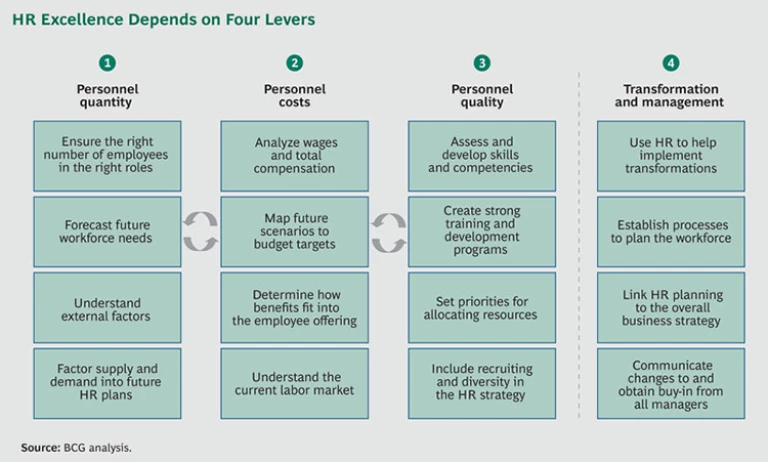As the pace of business accelerates and competition intensifies, companies in virtually all industries are confronting greater uncertainty and complexity. In the face of such challenges, human resources has the potential to be a crucial asset by ensuring that companies have the human capital they need to compete and the ability to react fast to changing environments.
Yet such HR departments are typically the exception, not the rule. In fact, the HR model at many companies—particularly established ones that have been in business for a long time—is increasingly outdated and insufficient to help them navigate the current environment. In this model, HR still functions in its traditional role as a service provider that focuses on transactions, rather than as a true partner to the business units. Most business problems are people problems—particularly in service industries—and this outdated HR model can prevent companies from making the changes needed to compete more effectively.
Conversely, if HR can adopt a more innovative and strategic role, it can have a positive multiplier effect. By optimizing company structures, developing and flexibly deploying company resources, and thus ensuring that the company has the right human capital in place, HR can help it meet its business objectives and improve both financial and operational performance. To get there, HR functions will need to adopt more efficient, forward-looking ways of working and take on a far more active role to support the business. Many organizations understand this objective, but they are less clear about how to achieve it. This article will propose specific measures that HR organizations can take and illustrate how one company successfully applied them.
Four Levers
On the basis of our experience in client engagements, we believe that adopting a more active role for HR requires addressing four levers—personnel quantity, personnel costs, personnel quality, and transformation and management—with company-specific activities supporting each lever. (See the exhibit “HR Excellence Depends on Four Levers.”) The first three are interrelated, while the fourth provides a foundation to ensure that companies can successfully implement changes. These four levers make up a balanced approach to HR management that can lead to considerable advantages, especially in a volatile business environment characterized by constant change and pressure to generate efficiencies. (For an example of such an approach in action, see “NORD/LB Revamps Its HR Model.”)
NORD/LB Revamps Its HR Model
While all industries must deal with a dynamic business environment, banking currently faces a unique combination of circumstances that have made operations far more difficult over the past few years. Uncertain macroeconomic conditions, changing regulations, and nimble new digital competitors have challenged incumbent banks, and many have relied on HR as a means of responding.
In 2013, NORD/LB, one of the largest commercial banks in Germany, realized it needed to reduce head count by about 15 percent to address these challenges. But management knew that a staff reduction alone wouldn’t be enough. Rather, it wanted to emerge from the process with HR as a strong strategic asset, leaving the bank better prepared to meet future challenges.
Before that point, the company’s HR function did not have a clear idea of the workforce’s skills and competencies. Nor was it aware of workforce supply and demand across the organization: one department might have sought to fill a vacant position externally, without knowing about a qualified candidate in an adjacent department.
In response, NORD/LB set up a centralized database with standard nomenclature regarding job titles, descriptions, and skill levels. The bank also analyzed the qualifications for all positions, along with the cost and effort required to fill vacant positions, and it categorized employees using a three-part hierarchy—job, cluster, and group—corresponding to the similarities between positions.
The bank also established guidelines for filling vacant positions, using a similar hierarchy and with cost-effectiveness as the most important consideration. (See the exhibit below.) When a position needs to be filled, the bank first considers internal candidates who can be deployed most quickly and with the lowest cost (generally from existing positions that are highly similar to the open job). If no candidates are available, a multistep process gradually widens the scope of the search to employees in similar job clusters and then job groups. If the company still cannot find a match, it looks for an external candidate. This process simplifies hiring decisions and allows the company to fill positions in a way that minimizes disruption, training time, and costs for the successful candidate. It has correspondingly larger benefits during company efforts such as restructuring.
As a result, NORD/LB not only managed to achieve its target head-count reduction in an efficient and sustainable way; it also gained a much stronger understanding of the supply and demand for talent across the organization. The bank established a clear system with rules for filling vacant positions and for using HR measures most efficiently—in a way that benefits both the organization and the employee—and it now has accurate data to help it improve its HR performance over time.
Personnel Quantity. In addressing the first lever—personnel quantity—HR must ensure that the company has the right number of employees in the right roles and under the right employment conditions (such as full-time, part-time, or flex-time). This is not a static situation. Best-in-class HR departments can project forward and assess how the organization’s business strategy will translate to specific workforce needs. These HR functions also understand external factors that might shape the supply of talent, such as changes in the education landscape, demographic shifts, and other trends. Finally, leading HR functions have planning processes to address potential imbalances between supply and demand, including finding the right balance between developing internal talent and hiring from external sources.
Personnel Costs. The second lever, personnel costs, considers the financial implications of the workforce. Top-performing HR functions are able to give a highly detailed accounting of the company’s current employment costs (in both wages and total compensation). They can also assess the implications of various scenarios, map those scenarios to budget targets, and accurately forecast future personnel costs regardless of market shifts. Critically, the cost lever also requires a consistent compensation strategy—including how benefits fit into the overall value offering to potential employees—which in turn means understanding the current market for labor and management, and the degree to which the company can use compensation to recruit and retain talent.
Personnel Quality. In addition to the quantity of employees, HR must assess and develop the workforce’s skills and competencies. This third lever entails defining the tasks and required certifications for all current job categories, assessing how well the company is meeting those objectives, and determining how employees will need to develop over time to meet future business goals. Top-performing HR functions have strong talent-management and training-and-development programs, with priorities for how to allocate resources and generate the largest payoff in terms of new skills, capabilities, and certifications. Last, they understand how recruiting and diversity initiatives fit into the larger HR strategy. (BCG research has established that talent management is one of the most urgent priorities for HR functions across industries worldwide. See Creating People Advantage 2014-2015: How to Set Up Great HR Functions, BCG report, December 2014.)
Across all three levers—personnel quantity, costs, and quality—scenario planning is crucial. As the business environment becomes more volatile, the ability to react fast to changes and plan human-capital needs several years ahead, across a wide range of potential situations, will become a key differentiator for companies. HR departments that can accurately predict and plan for future needs will keep their companies ahead of the curve, while those that cannot will be repeatedly surprised by events—and consistently behind in reacting to them.
Transformation and Management. The fourth lever is managing the process of change—both within the HR organization and, more broadly, across the entire company. This lever is essential if HR is to take on a more innovative and strategic role and thus successfully support company-wide transformations, reorganizations, and efficiency programs. Companies need to establish processes and rules by which HR can centrally plan the workforce using objective criteria. Furthermore, these criteria have to be linked to the company’s overall business strategy and financial objectives, and they must be clearly communicated and accepted by all managers. This requires a significant change at many companies, especially in the HR function itself. People will have to change the way they work, with new roles and responsibilities, different objectives, and different metrics to gauge performance.
Data Is Critical
A critical success factor that supports all four levers is data. Transparent data is the foundation for fact-based, quantitative HR work. Company leaders cannot make the right human-capital decisions if they don’t have an accurate understanding of their personnel situation, and they can manage only the things they measure. Accordingly, companies need to establish a reliable source of high-quality personnel data on the basis of standardized processes, clear responsibilities, and unambiguous terminology. The data must be far richer and more detailed than that currently tracked by many companies.
In addition, companies must frequently aggregate and report this data to the people who need its insights in order to make smarter decisions. The reports should be oriented toward the business requirements of the recipients—rather than the traditional metrics of HR—so that the information can yield real value; this is seldom the case at many companies today. As part of this effort, companies should establish a standard set of regular HR reports for different purposes (such as development, performance, and steering) and provide them to specific groups (for example, board members, business unit leaders, or employee representatives). These reports keep the different groups informed about overall company developments, support discussions among them, reveal required HR action in specific units, and provide a basis for HR decisions.
With the right data foundation in place, companies can begin establishing the processes needed to make personnel management more efficient. For example, all HR measures that influence the personnel budget should be linked and aggregated—through data—so that HR leaders have a clear and current view of their financial situation. Routine personnel events (such as hires, departures, and internal transfers), along with larger initiatives (such as job cuts, department expansions, or changes in the organization structure), should all be simultaneously entered into HR controlling and financial controlling databases. By establishing such a systematic approach, in which all HR measures are aligned and in sync, companies can efficiently deploy the right workforce, especially in the case of company-wide changes such as a restructuring or reorganization. As a result, HR and business leaders have an accurate and real-time indication of the company’s personnel situation—across quantity, cost, and quality dimensions.
In the current operating environment, companies in all industries must become leaner and more agile, with a greater focus on human capital than on hard assets. The efficient, flexible deployment of HR resources is a central element of a company’s ability to compete, invest, and remain viable and successful. HR can be a critical differentiator in helping management teams achieve their objectives, but only if HR departments can change the way they work and adopt a more active role. Getting there requires focusing on the four levers we have identified—the quantity, costs, and quality of personnel, along with transformation and management—and supporting them with accurate data. The HR departments that succeed in this effort will not only improve their personnel management performance but also strengthen the company’s overall performance, giving it a critical edge over competitors regardless of what the future holds.






